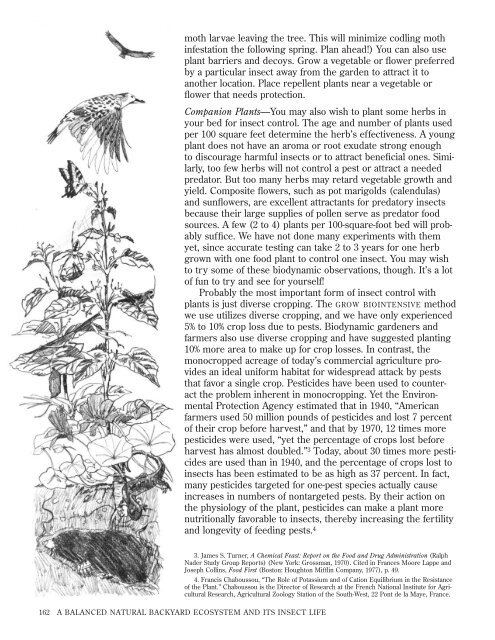How to Grow More Vegetables : And Fruits, Nuts ... - Shroomery
How to Grow More Vegetables : And Fruits, Nuts ... - Shroomery
How to Grow More Vegetables : And Fruits, Nuts ... - Shroomery
Create successful ePaper yourself
Turn your PDF publications into a flip-book with our unique Google optimized e-Paper software.
moth larvae leaving the tree. This will minimize codling moth<br />
infestation the following spring. Plan ahead!) You can also use<br />
plant barriers and decoys. <strong>Grow</strong> a vegetable or flower preferred<br />
by a particular insect away from the garden <strong>to</strong> attract it <strong>to</strong><br />
another location. Place repellent plants near a vegetable or<br />
flower that needs protection.<br />
Companion Plants—You may also wish <strong>to</strong> plant some herbs in<br />
your bed for insect control. The age and number of plants used<br />
per 100 square feet determine the herb’s effectiveness. A young<br />
plant does not have an aroma or root exudate strong enough<br />
<strong>to</strong> discourage harmful insects or <strong>to</strong> attract beneficial ones. Similarly,<br />
<strong>to</strong>o few herbs will not control a pest or attract a needed<br />
preda<strong>to</strong>r. But <strong>to</strong>o many herbs may retard vegetable growth and<br />
yield. Composite flowers, such as pot marigolds (calendulas)<br />
and sunflowers, are excellent attractants for preda<strong>to</strong>ry insects<br />
because their large supplies of pollen serve as preda<strong>to</strong>r food<br />
sources. A few (2 <strong>to</strong> 4) plants per 100-square-foot bed will probably<br />
suffice. We have not done many experiments with them<br />
yet, since accurate testing can take 2 <strong>to</strong> 3 years for one herb<br />
grown with one food plant <strong>to</strong> control one insect. You may wish<br />
<strong>to</strong> try some of these biodynamic observations, though. It’s a lot<br />
of fun <strong>to</strong> try and see for yourself!<br />
Probably the most important form of insect control with<br />
plants is just diverse cropping. The GROW BIOINTENSIVE method<br />
we use utilizes diverse cropping, and we have only experienced<br />
5% <strong>to</strong> 10% crop loss due <strong>to</strong> pests. Biodynamic gardeners and<br />
farmers also use diverse cropping and have suggested planting<br />
10% more area <strong>to</strong> make up for crop losses. In contrast, the<br />
monocropped acreage of <strong>to</strong>day’s commercial agriculture provides<br />
an ideal uniform habitat for widespread attack by pests<br />
that favor a single crop. Pesticides have been used <strong>to</strong> counteract<br />
the problem inherent in monocropping. Yet the Environmental<br />
Protection Agency estimated that in 1940, “American<br />
farmers used 50 million pounds of pesticides and lost 7 percent<br />
of their crop before harvest,” and that by 1970, 12 times more<br />
pesticides were used, “yet the percentage of crops lost before<br />
harvest has almost doubled.” 3 Today, about 30 times more pesticides<br />
are used than in 1940, and the percentage of crops lost <strong>to</strong><br />
insects has been estimated <strong>to</strong> be as high as 37 percent. In fact,<br />
many pesticides targeted for one-pest species actually cause<br />
increases in numbers of nontargeted pests. By their action on<br />
the physiology of the plant, pesticides can make a plant more<br />
nutritionally favorable <strong>to</strong> insects, thereby increasing the fertility<br />
and longevity of feeding pests. 4<br />
3. James S. Turner, A Chemical Feast: Report on the Food and Drug Administration (Ralph<br />
Nader Study Group Reports) (New York: Grossman, 1970). Cited in Frances Moore Lappe and<br />
Joseph Collins, Food First (Bos<strong>to</strong>n: Hough<strong>to</strong>n Mifflin Company, 1977), p. 49.<br />
4. Francis Chaboussou, “The Role of Potassium and of Cation Equilibrium in the Resistance<br />
of the Plant.” Chaboussou is the Direc<strong>to</strong>r of Research at the French National Institute for Agricultural<br />
Research, Agricultural Zoology Station of the South-West, 22 Pont de la Maye, France.<br />
162 A BALANCED NATURAL BACKYARD ECOSYSTEM AND ITS INSECT LIFE












